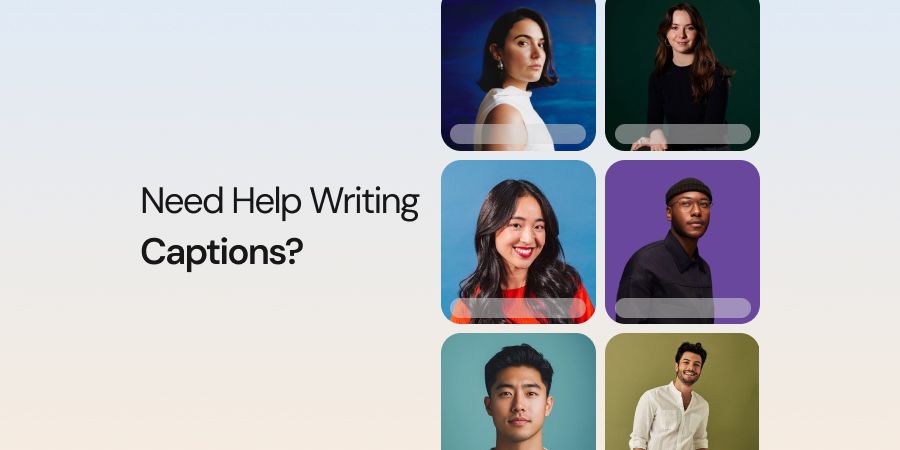
How to Write Photo Captions That Last and Leave an Impression
A photograph captures a moment. A well-written caption keeps that moment alive. Without words, an image can drift into mystery, leaving future viewers unsure of who, what, or when.
With the right line beneath it, a picture becomes part of a story that can be passed on and understood for years. And writing a photo caption is not as easy and simple as writing a memoir, it is much more delicate, yet allows for raw and unfiltered emotions.
That said, photo captions are not only for history books. They belong in family albums, digital archives, school projects, and social media posts. A few well-chosen words can bring clarity to an old snapshot, explain the scene in a report, or give character to an online gallery.
This guide explores what a caption is, shows caption writing examples, and offers practical steps so your photos always speak with meaning.
What Is a Photo Caption?
A photo caption is a short piece of text placed with an image. Its purpose is to explain what the picture shows and why it matters. A caption may include names, dates, places, and context that the eye alone cannot supply.
What does a caption look like? It can be as simple as:
“Anna and Jacob at their wedding, June 2010.”
Or it can carry a little more detail:
“Anna and Jacob at their wedding, June 2010, surrounded by friends who had traveled across the country to celebrate with them.”
Both are correct as we don’t judge right or wrong when writing captions. The first gives the essentials. The second adds warmth and depth. The right choice depends on the purpose of the photo and the audience reading it.
Anatomy of a Strong Photo Caption
A useful caption holds a few key parts.
-
Names and Relationships
Identify the people in the photo. Use full names at least once, then shorter forms later if they appear again.
-
Time and Place
Add a date, year, or season. Note the location, whether it is a city, a house, or a natural setting.
-
Action and Meaning
Describe what is happening in the picture. A picture caption that includes a strong verb can make the scene come alive.
-
Source or Credit
Mention the photographer or the collection when relevant, especially in reports or published works.
-
Length Balance
Keep it brief. One or two sentences are usually enough to provide clarity without overwhelming the image.
Example Caption for a Photo
Weak: “The whole group.”
Better: “Friends gathered on the hillside during the summer reunion, July 2018.”
The second version places names, context, and time around the image, so that it remains clear even years later. If you want AI written photo captions, you can either try ChatGPT and make it write like a human, or explore ChatGPT competitors in the space.
Principles of Writing Photo Captions
A caption should feel clear, honest, and timeless. The best lines carry just enough information for the picture to make sense without repeating what the eye already sees. Think of it as a bridge between memory and meaning.
-
Be Specific
Details anchor a photograph. Names, dates, and places are more valuable than vague phrases like “the gang” or “our trip.”
-
Stay Concise
One strong sentence is often more powerful than three meandering lines. A photo caption that is short and complete will stay readable decades later.
-
Keep Language Plain
Simple verbs like “walks,” “smiles,” or “holds” are easier to trust than long, decorative phrases.
-
Be Consistent
If one caption uses a full name, the next should not suddenly switch to a nickname. Consistency makes a collection easier to follow.
-
Add Time Markers
Dates, years, or seasons give the photo its place in history. Even an approximate year is better than none.
-
Respect Tone
Humor can work, but only when gentle and relevant. Captions are not the place for private jokes that may lose meaning outside their moment.
Photo Caption Writing Examples
Examples help show what a caption for a photo should look like. Below are pairs of weak and stronger versions.
Photo Caption for Family Gathering
Weak: “The cousins.”
Better: “Eleanor, James, and Grace at the family picnic, August 1995.”
Photo Caption for an Action Visual
Weak: “Running.”
Better: “Michael crosses the finish line of the city marathon in under four hours, April 2022.”
Photo Caption for Office Group
Weak: “Team.”
Better: “Design and engineering team celebrating the launch of their new app, October 2023.”
Photo Caption for an Old Meetup
Weak: “Me and Dad.”
Better: “Sarah with her father, David Turner, standing in front of their home, c. 1970.”
Each improved version offers context that transforms the image into a piece of history. Readers no longer guess at names or moments, they understand them.
Format and Placement of Photo Captions
Captions sit close to the photo, usually just beneath it. They should look connected to the image but distinct from the main text of a page or article.
-
Font and Size
Use a typeface that remains legible at smaller sizes. If the body text is serif, a sans-serif caption can provide contrast, or the other way around.
-
Spacing
Leave white space above and below to keep the caption separate from long paragraphs. This ensures the reader links the line to the picture only.
-
Digital Layouts
In online galleries, captions may appear below thumbnails or inside a lightbox view. On social media, captions form part of the post itself and can be longer. Regardless of format, the goal remains the same: clarity and context.
A caption for pictures in a printed book may look quiet and understated, while captions for photos online often carry more character. In both cases, the line must help the image speak clearly.
How to Write a Caption Step by Step
Writing a photo caption becomes easier when it follows a steady sequence. Each step adds a layer that turns a plain note into a clear record.
-
Identify people
Write their full names the first time they appear. If they return in later photos, shorter forms are enough. Confirm spellings carefully – names are often the most miswritten detail.
-
Add time and place
A date or year places the picture in history. A city, landmark, or event sets the scene. Even an approximate date such as “c. 1940s” holds value for future readers.
-
Describe the action
One strong verb gives energy to the caption. Words like “walks,” “smiles,” “signs,” or “celebrates” tell the reader what is happening.
-
Add context only when useful
If a short explanation deepens understanding, include it. Mentioning that a picnic was the first family gathering in ten years makes the moment richer.
-
Credit the source
A professional photo or historical archive needs acknowledgement. Add “Photo by [Name]” at the end or in parentheses.
-
Read it aloud
A caption should sound natural in speech. If it feels heavy or unclear, trim it until it flows.
Photo Caption Templates You Can Reuse
Photo caption templates help create captions that remain consistent across albums or projects. These simple forms can be adjusted to fit many situations.
-
People + Place
“[Name(s)] at [location], [city], [month, year].”
Example: “Anna and Lucas at Central Park, New York, April 2015.” -
Event
“[Name] at [event], [role or result], [date].”
Example: “David presenting at the annual design conference, September 2021.” -
Historic
“[Full name] with [companion] at [place], [approximate year].”
Example: “Margaret Lee with her brother outside their childhood home, c. 1952.” -
Object
“[Object] used for [purpose], [owner], [location], [year].”
Example: “Vintage typewriter used by author Helen Carter, London, 1970.” -
Social Post
“[Hook detail]. [Names], [place], [date].”
Example: “First sunrise of the year. Emma and Chloe, Brighton Beach, January 2023.”
These templates show what a caption looks like in different styles such as short, factual, or slightly poetic.
Practice Writing Captions for Pictures
Practice strengthens skill. Using sample pictures for caption writing helps turn the method into habit. Here are three exercises:
-
Family picnic with three generations
-
Identify each person in the photo.
-
Add the name of the park and city.
-
Note the month or year.
-
Include one detail, such as “sharing strawberry pie” or “gathered for grandmother’s birthday.”
-
-
Graduation photo on university steps
-
Write the graduate’s full name and degree.
-
Include the institution.
-
Add the year.
-
Mention if family members or friends appear in the frame.
-
-
Product close-up on a desk
-
Name the product and model.
-
State the purpose of the item.
-
Mention the setting if useful, such as “photographed in the design studio, 2022.”
-
Each example of caption of a picture created through these exercises balances brevity with clarity. Practicing on varied scenes helps you write captions that feel natural across albums, reports, or online posts.
Photo Caption Style for Different Uses
-
Family Albums and Personal History
A caption for old photo albums does more than mark names. It preserves relationships, maiden names, and approximate years that later generations would not know.
An example of a photo caption of a picture might be: “Elizabeth Harris with her sister Margaret, standing in front of their childhood home, c. 1950.”
This type of detail keeps a photograph from fading into mystery.
-
Social Media
For example: “First day at the new studio, March 2023.”
Readers immediately understand the context without scrolling through a long explanation.
-
Journalism and Reporting
A picture caption in a news report or newspaper must be neutral and factual. Verification matters more than style and expression.
An example: “Mayor addressing the opening ceremony of the arts festival, June 2024.”
Such captions rely on accuracy. They provide identity, place, and date without adding personal interpretation.
-
Marketing and Portfolios
In professional work, captions help clients and audiences connect the photo to a result, which matters more than the emotional connection in most contexts.
A caption for a product photo might read: “Prototype of the new smart speaker, displayed at the innovation summit, 2022.”
The line gives clarity, time, and place while supporting the purpose of the portfolio.
Ethics and Sensitivity in Photo Caption Writing
Captions carry responsibility, especially in today’s times where information and misinformation overload makes things hard to comprehend. Words chosen with care protect dignity and context.
-
Consent: Do not identify minors or private individuals in public collections without permission.
-
Cultural Respect: Use language that honors traditions and avoids stereotypes.
-
Sensitive Scenes: A calm, factual tone suits images of memorials, disasters, or crisis events. Humor or casual remarks in such contexts harm trust.
-
Corrections: Mistakes in names, dates, or places should be corrected quickly. Captions form part of a permanent record.
An example of a respectful photo caption might be: “Volunteers distributing supplies during community relief efforts by the ABC Foundation, August 2021.”
The photo caption above is clear, factual, and considerate.
Common Mistakes to Avoid When Writing Photo Captions
A caption for a picture fails when it leaves the reader guessing (unless intended). Common errors weaken the purpose of photo captions.
-
Using vague words such as “friends” or “the team” without giving names.
-
Repeating the obvious. A caption on photo albums that reads “A man holding a cup” adds nothing if the photo already shows that clearly.
-
Skipping time and place. A caption for pictures without a year or location loses its anchor.
-
Filling captions with inside jokes or slang that will not age well.
-
Misspelling names or leaving out credits. Small errors damage credibility.
A caption that avoids these pitfalls becomes a reliable companion to the photo.
Photo Caption Writing Examples Library
A collection of examples helps show how different captions work in practice. These photo caption writing examples cover personal, professional, and creative uses.
-
Street Portrait
“Daniel Rivera outside the old train station on a cool autumn morning, c. 1978. The station closed later that year, making this one of the last photos taken at the site.”
-
Classroom Scene
“Students attending a literature lecture during the spring semester of 2021, listening as the professor reads aloud from a classic novel.”
-
Wedding Group Photo
“Sofia and Mark with their families at the reception in September 2019, surrounded by flowers and candlelight during an evening celebration.”
-
Museum Object
“Bronze compass used in early sea voyages, displayed under soft light at the Maritime Gallery, showing signs of wear from decades of navigation.”
-
Team Retreat
“Company staff gathered in the garden during the annual retreat, June 2022, sharing stories and laughter before the evening workshop began.”
-
Product Launch
“Demonstration of the latest smartwatch during the global tech summit, 2023, where the audience watched as new health features were unveiled.”
-
Travel Snapshot
“Evening light falling across the historic bridge, July 2020, with silhouettes of travelers pausing to admire the view.”
-
Sports Finish Line
“Emma crossing the finish line of the city marathon in April 2024, raising her arms in victory after running under three hours.”
-
Food Photography
“Seasonal fruit tart prepared by Chef Laura in 2021, arranged with fresh berries and glazed to catch the light for a summer menu launch.”
-
Caption for an Old Photo
“Family gathered on the farmhouse porch, c. 1945, children sitting barefoot on the steps while elders look on with quiet smiles.”
Each picture caption example above uses simple language, identifies the subject, and fixes the moment in time. These samples show what a caption for a picture looks like when done with care.
How Gen Z Writes Photo Captions Today
Gen Z captions often feel like fragments of culture – short, emotional, and layered with humor or mood. Instead of explaining everything, they leave space for interpretation, relying on tone, emojis, and cultural references that connect instantly with their audience.
1. The Minimalist One-Liner
This type of caption says very little yet sets the mood. A single word or short phrase frames the image without stealing attention from it.
-
“lost in thought.”
-
“weekend things.”
-
“in my element.”
2. Emoji-Only Captions
Emojis often replace full sentences in Gen Z caption writing. A few symbols can signal the feeling of the moment or hint at the story behind the photo.
-
🌊☀️
-
🖤🔥
-
🎧🎶
3. Irony and Self-Awareness
Humor and self-reflection mix here. The caption draws attention to the act of posting itself, creating relatability through sarcasm or playful honesty.
-
“posting so i don’t forget i exist.”
-
“me pretending i like salads.”
-
“proof i left the house.”
4. Pop Culture References
Song lyrics, memes, and viral lines form another Gen Z caption style. The reference often matters more than the literal connection between photo and text.
-
“main character energy.”
-
“she’s beauty, she’s grace…”
-
“straight outta storage.”
5. Soft and Aesthetic Lines
Not every caption leans on irony. Many Gen Z captions carry a poetic, dreamy tone, pairing mood-driven words with carefully styled photos.
-
“painted skies, tired eyes.”
-
“the world was quiet here.”
-
“lost in the golden light.”
6. Inside Jokes
-
“remember the chair incident?”
-
“this one’s for you, pizza squad.”
-
“don’t ask.”
7. Overly Dramatic for Humor
-
“day 52 in the wilderness.”
-
“a tragic hero.”
-
“the fall of greatness.”
Quick Reference Checklist for Photo Captions
A short checklist helps keep caption writing consistent. Before finalizing, review each line against these points:
-
Names written clearly and spelled correctly.
-
Date and location added.
-
Action or context expressed in one strong sentence.
-
Photographer or source credited if required.
-
Tone respectful, readable, and free of clutter.
This list can be applied to family albums, professional reports, school projects, or social posts.
How to Write Captions Using Chatly?
Chatly can be used as a practical tool for creating photo captions that are clear, consistent, and tailored to different needs. Here are ways it can help:
-
AI Chat for Quick Drafts
Describe the picture in plain words, and Chatly suggests a caption you can refine or you can use different models, including the latest GPT-5.
-
Multiple Style Options
Generate different tones – factual for reports, warm for albums, or concise for social posts.
-
AI Search for Context
Look up dates, places, or events to add accurate detail, especially when writing captions for old photos.
-
Prompt Library
Build reusable prompts like “Write a caption with name, place, and year” or “Add a gentle humorous note.” This keeps large sets of captions consistent.
-
Editing Support
Ask Chatly AI Chat to shorten long lines, expand brief notes, or offer fresh variations until the caption feels right.
These steps turn Chatly into a partner in photo caption writing. Each caption for photos can be prepared faster, with enough detail to stay meaningful for years.
Suggested read: How to Write AI Art Prompts
Closing Thoughts
A photograph can capture light and shadow, but a caption gives it voice. Without a line beneath the image, names fade and dates slip away. With a few words, the moment regains clarity and meaning.
Caption writing does not demand long sentences or clever tricks. It asks only for honesty and care. Add the names of the people, the time and place, and a touch of context where it helps. The result is a caption for photos that will remain useful and readable for years.
Each photo deserves words that protect its story. Writing them takes only a moment, but that moment can decide how the picture will be remembered.
Frequently Asked Questions About Writing Photo Captions
Here are the most common questions we get related to writing photo captions.
More topics you may like

How to Write a Brand Collaboration Proposal in 2025

Muhammad Bin Habib

How to Write a Case Report in 2025

Muhammad Bin Habib

How to Write a Cover Letter with No Experience Using AI Chat

Muhammad Bin Habib

11 Best ChatGPT Alternatives (Free & Paid) to Try in 2025 – Compare Top AI Chat Tools

Muhammad Bin Habib

Best AI Writing Tools That You Can Use in 2025 (Free & Paid)

Muhammad Bin Habib
